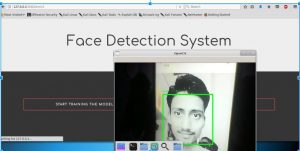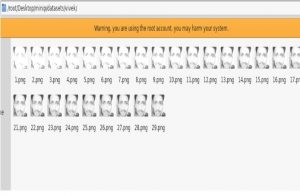使用带有网络摄像头的Python和 OpenCV 进行人脸检测
OpenCV 是一个库,用于使用诸如Python之类的编程语言进行图像处理。该项目利用 OpenCV 库使用您的网络摄像头作为主摄像头进行实时人脸检测。
以下是它的要求:-
- Python2.7
- 开放式CV
- 麻木的
- Haar Cascade 正面人脸分类器
使用的方法/算法:
- 该项目使用 LBPH(Local Binary Patterns Histograms)算法来检测人脸。它通过对每个像素的邻域进行阈值处理来标记图像的像素,并将结果视为二进制数。
- LBPH 使用 4 个参数:
(i) 半径:半径用于构建圆形局部二值模式,表示周围的半径
中心像素。
(ii) 邻居:构建圆形局部二进制模式的样本点数。
(iii) 网格 X:水平方向上的单元格数。
(iv) Grid Y:垂直方向的单元格数。 - 所构建的模型使用带有标签的人脸进行训练,然后,机器得到一个测试数据,机器为其决定正确的标签。
如何使用 :
- 在你的电脑上创建一个目录并命名它(比如项目)
- 创建两个Python文件,分别命名为create_data.py和face_recognize.py,分别复制第一个源代码和第二个源代码。
- 将haarcascade_frontalface_default.xml复制到工程目录下,可以在opencv或者从
这里。 - 您现在已准备好运行以下代码。
Python
# Creating database
# It captures images and stores them in datasets
# folder under the folder name of sub_data
import cv2, sys, numpy, os
haar_file = 'haarcascade_frontalface_default.xml'
# All the faces data will be
# present this folder
datasets = 'datasets'
# These are sub data sets of folder,
# for my faces I've used my name you can
# change the label here
sub_data = 'vivek'
path = os.path.join(datasets, sub_data)
if not os.path.isdir(path):
os.mkdir(path)
# defining the size of images
(width, height) = (130, 100)
#'0' is used for my webcam,
# if you've any other camera
# attached use '1' like this
face_cascade = cv2.CascadeClassifier(haar_file)
webcam = cv2.VideoCapture(0)
# The program loops until it has 30 images of the face.
count = 1
while count < 30:
(_, im) = webcam.read()
gray = cv2.cvtColor(im, cv2.COLOR_BGR2GRAY)
faces = face_cascade.detectMultiScale(gray, 1.3, 4)
for (x, y, w, h) in faces:
cv2.rectangle(im, (x, y), (x + w, y + h), (255, 0, 0), 2)
face = gray[y:y + h, x:x + w]
face_resize = cv2.resize(face, (width, height))
cv2.imwrite('% s/% s.png' % (path, count), face_resize)
count += 1
cv2.imshow('OpenCV', im)
key = cv2.waitKey(10)
if key == 27:
breakPython
# It helps in identifying the faces
import cv2, sys, numpy, os
size = 4
haar_file = 'haarcascade_frontalface_default.xml'
datasets = 'datasets'
# Part 1: Create fisherRecognizer
print('Recognizing Face Please Be in sufficient Lights...')
# Create a list of images and a list of corresponding names
(images, labels, names, id) = ([], [], {}, 0)
for (subdirs, dirs, files) in os.walk(datasets):
for subdir in dirs:
names[id] = subdir
subjectpath = os.path.join(datasets, subdir)
for filename in os.listdir(subjectpath):
path = subjectpath + '/' + filename
label = id
images.append(cv2.imread(path, 0))
labels.append(int(label))
id += 1
(width, height) = (130, 100)
# Create a Numpy array from the two lists above
(images, labels) = [numpy.array(lis) for lis in [images, labels]]
# OpenCV trains a model from the images
# NOTE FOR OpenCV2: remove '.face'
model = cv2.face.LBPHFaceRecognizer_create()
model.train(images, labels)
# Part 2: Use fisherRecognizer on camera stream
face_cascade = cv2.CascadeClassifier(haar_file)
webcam = cv2.VideoCapture(0)
while True:
(_, im) = webcam.read()
gray = cv2.cvtColor(im, cv2.COLOR_BGR2GRAY)
faces = face_cascade.detectMultiScale(gray, 1.3, 5)
for (x, y, w, h) in faces:
cv2.rectangle(im, (x, y), (x + w, y + h), (255, 0, 0), 2)
face = gray[y:y + h, x:x + w]
face_resize = cv2.resize(face, (width, height))
# Try to recognize the face
prediction = model.predict(face_resize)
cv2.rectangle(im, (x, y), (x + w, y + h), (0, 255, 0), 3)
if prediction[1]<500:
cv2.putText(im, '% s - %.0f' %
(names[prediction[0]], prediction[1]), (x-10, y-10),
cv2.FONT_HERSHEY_PLAIN, 1, (0, 255, 0))
else:
cv2.putText(im, 'not recognized',
(x-10, y-10), cv2.FONT_HERSHEY_PLAIN, 1, (0, 255, 0))
cv2.imshow('OpenCV', im)
key = cv2.waitKey(10)
if key == 27:
break在为人脸训练模型后,应运行以下代码:
Python
# It helps in identifying the faces
import cv2, sys, numpy, os
size = 4
haar_file = 'haarcascade_frontalface_default.xml'
datasets = 'datasets'
# Part 1: Create fisherRecognizer
print('Recognizing Face Please Be in sufficient Lights...')
# Create a list of images and a list of corresponding names
(images, labels, names, id) = ([], [], {}, 0)
for (subdirs, dirs, files) in os.walk(datasets):
for subdir in dirs:
names[id] = subdir
subjectpath = os.path.join(datasets, subdir)
for filename in os.listdir(subjectpath):
path = subjectpath + '/' + filename
label = id
images.append(cv2.imread(path, 0))
labels.append(int(label))
id += 1
(width, height) = (130, 100)
# Create a Numpy array from the two lists above
(images, labels) = [numpy.array(lis) for lis in [images, labels]]
# OpenCV trains a model from the images
# NOTE FOR OpenCV2: remove '.face'
model = cv2.face.LBPHFaceRecognizer_create()
model.train(images, labels)
# Part 2: Use fisherRecognizer on camera stream
face_cascade = cv2.CascadeClassifier(haar_file)
webcam = cv2.VideoCapture(0)
while True:
(_, im) = webcam.read()
gray = cv2.cvtColor(im, cv2.COLOR_BGR2GRAY)
faces = face_cascade.detectMultiScale(gray, 1.3, 5)
for (x, y, w, h) in faces:
cv2.rectangle(im, (x, y), (x + w, y + h), (255, 0, 0), 2)
face = gray[y:y + h, x:x + w]
face_resize = cv2.resize(face, (width, height))
# Try to recognize the face
prediction = model.predict(face_resize)
cv2.rectangle(im, (x, y), (x + w, y + h), (0, 255, 0), 3)
if prediction[1]<500:
cv2.putText(im, '% s - %.0f' %
(names[prediction[0]], prediction[1]), (x-10, y-10),
cv2.FONT_HERSHEY_PLAIN, 1, (0, 255, 0))
else:
cv2.putText(im, 'not recognized',
(x-10, y-10), cv2.FONT_HERSHEY_PLAIN, 1, (0, 255, 0))
cv2.imshow('OpenCV', im)
key = cv2.waitKey(10)
if key == 27:
break
注意:以上程序不会在在线 IDE 上运行。
节目截图
它可能看起来有些不同,因为我已经在烧瓶框架上集成了上述程序
运行第二个程序会产生类似于下图的结果:

人脸检测
数据集存储:

数据集